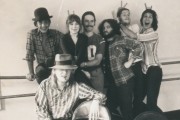 In one word, Le Havre — named after the port city in Normandy in which the film takes place – is beautiful. Visually La Havre (at least how writer/director Aki Kaurismäki and cinematographer Timo Salminen shoot it) resembles the pastel ethereal quality that fans of Wes Anderson will immediately recognize, only to come to the realization that Anderson didn’t actually invent that “unique” style. Of course, a film needs a lot more than visuals to make it a success, and while Le Havre has a compelling story it just isn’t compelling enough to keep you emotionally invested in the characters.
In one word, Le Havre — named after the port city in Normandy in which the film takes place – is beautiful. Visually La Havre (at least how writer/director Aki Kaurismäki and cinematographer Timo Salminen shoot it) resembles the pastel ethereal quality that fans of Wes Anderson will immediately recognize, only to come to the realization that Anderson didn’t actually invent that “unique” style. Of course, a film needs a lot more than visuals to make it a success, and while Le Havre has a compelling story it just isn’t compelling enough to keep you emotionally invested in the characters.
Marcel Marx (André Wilms), an aging shoe shiner who lives in a world that seems to have less and less of a need for shoe shiners. Every day he finds himself confronted by two far more modern problems that his relatively unsuccessful trade: not only has his wife Arletty (Kati Outinen) fallen ill, but he finds himself caught in the predicament of Idrissa (Blondin Miguel), a young illegal African refugee who seeks to reunite with his family in London. Wilms is wonderful, and often quite funny, as Marcel, and his clever interactions with his fellow townsfolk of Le Havre – some who adore him despite his deadbeat ways and others who consider him a public nuisance – are a highlight of the film. How he manages to rally the town behind the troubles of Idrissa definitely would crack a smile in even the most stone-faced viewer.
Yet while I hate to categorize European films into one all-encompassing category, this film does follow the disconnected storylines that nonetheless imply some sort of “karmatic” connection that the films of Fellini and Bergman tend to fall back on (often brilliantly). Le Havre does something similar, as Marcel finds himself not only trying to solve Idrissa’s predicament but also is faced with his wife’s battle with a serious illness (the severity of which she keeps a secret from him). Naturally, when Marcel struggles with his responsibility for Idrissa it appears Arletty is getting worse, but when he helps Idrissa it seems like her condition improves, as if there is a direct connection of universality between the two otherwise unrelated situations. It’s something that is so entrenched in the structure of European cinema that even though Kaurismäki teases an unhappy ending we know that just isn’t going to happen.
As a result, the film is ultimately not as compelling as you’d expect about a man hiding an illegal refugee – this is no Diary of Anne Frank, nor should it be. The film’s villain, the police inspector Monet (Jean-Pierre Darroussin), is of course dressed in all black as he pursues Marcel with suspicions that he is hiding the fugitive boy. He’s never quite evil enough to make us think Idrissa is in any real danger of being found out, though I assume that might be Kaurismäki’s point based on how the Monet character develops. Still, since Idrissa hardly speaks it’s hard to develop a connection with such an obviously important character if we never actually worry about his ultimate fate. Curiously, District 9, a science fiction film, had a far more relevant commentary on illegal immigration despite using non-human computer generated characters as the refugees. Yes, District 9 is a vastly different film, but it offers a more compelling narrative than La Havre.
Le Harve is Finland’s official submission for the 2012 Foreign Language Oscar, and while I don’t think La Havre is quite good enough to win the award in what is always a hotly-contested category, at the very least it deserves a look if you like the cinematic romantic modern fairy tales like Amelie that European directors have perfected and American filmmakers have never quite figured out how to copy after all these years.
Rating: This cocktail of Amelie and District 9 isn’t as strong as its ingredients, but it sure looks great! (6.5/10)















Recent Comments